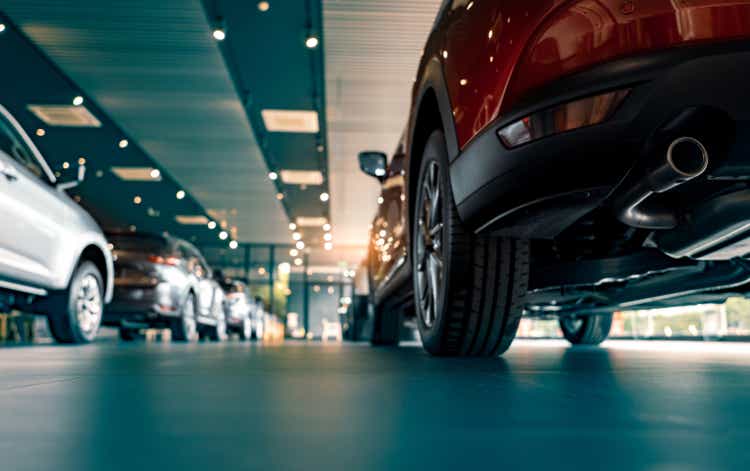Fahroni
The following segment was excerpted from this fund letter.
Asbury Automotive (NYSE:ABG): The Distribution Theme
Our holdings in car and branded capital equipment dealerships, convenience stores, building product distributors, automobile transportation logistics, and capital equipment leasing firms all fall into the distribution theme. One of the main KPIs for dealerships and shopping is velocity or inventory turns. We own some of the highest-velocity dealerships in markets around the world. Over the past two years, there have been challenges in some markets hit by COVID, like South Africa and Latin America; but we are seeing recovery now that vaccines have been approved and distributed.
One of our holdings in the distribution theme is Asbury Automotive, an automobile dealership firm. Asbury’s growth model is through same-store sales growth (4% per year), internet distribution (10% per year), and synergistic M&A (5% per year). These are enhanced by opportunistic operational leverage from scale and share repurchases (5% annual growth). Over the past 10 years, Asbury’s net income margins are up 120% with a 5x increase in revenues. These factors should lead to about a 20% EPS growth going forward. Ashtead has had 19% and 31% EPS growth over the past five and 10 years, respectively.
As can be seen below, a large portion of future growth is based upon the growth of internet sales. Both Asbury and Lithia have internet strategies which capture a younger demographic who do not visit dealerships with the same frequency as older folks. Asbury, through its online platform Clicklane, has found internet purchasers have very little overlap with existing customers; 95% are new customers. Asbury’s strategy is to target customers who are within 20 miles of an existing Asbury location vs. online only competitors (like Carvana) and Lithia. Asbury has had a per-store growth rate of 67% over the last year and only sells cars online in about 60% of its current footprint. This growth rate will decline going forward as the markets mature, but it will be bolstered as Clicklane is rolled out to the remaining 40% of Asbury’s footprint.
What complicates the outlook going forward is Asbury’s growth plan and the cyclicality of the auto dealership business. Asbury has the highest margins (due to local clustering) and inventory turns when compared to US companies, leading to high returns on equity of 33% to 41% over the past five years.
|
Asbury |
EPS Growth |
26% |
||||||||||||||
|
2021 |
2022 |
2023 |
2024 |
2025 |
2026 |
2027 |
2028 |
2029 |
$181.00 |
2.27 |
5-yr fwd PE |
5% growth PE |
||||
|
19.9% |
5.03 |
Earnings/FCF Yield |
18.5 |
|||||||||||||
|
Revs |
$9,837 |
$15,818 |
$20,000 |
$26,000 |
$33,900 |
$38,985 |
$44,833 |
$49,316 |
$54,248 |
|||||||
|
61% |
26% |
30% |
30% |
15% |
15% |
10% |
10% |
Revenue Drivers |
||||||||
|
SSS growth 4% |
||||||||||||||||
|
NI |
$549 |
$796 |
$738 |
$988 |
$1,284 |
$1,559 |
$1,793 |
$1,973 |
$2,170 |
Acquisitions – Unit growth 10% |
||||||
|
5.6% |
5.0% |
3.7% |
3.8% |
3.8% |
4.0% |
4.0% |
4.0% |
4.0% |
Internet (10%) |
|||||||
|
EPS |
$24.78 |
$35.97 |
$34.38 |
$47.45 |
$63.55 |
$79.59 |
$94.36 |
$107.01 |
$121.35 |
Market Cap |
Target Price |
$1,472 |
||||
|
45% |
-4% |
38% |
34% |
25% |
19% |
13% |
13% |
Shares |
22.131 |
$4,005.71 |
IRR |
52.1% |
||||
|
Repurchase Rate |
||||||||||||||||
|
Shares |
3% |
22.131 |
21.47 |
20.82 |
20.20 |
19.59 |
19.00 |
18.43 |
17.88 |
|||||||
Asbury currently trades for an EPS multiple of about 5.0x and an earnings yield of 20%, with low 20% EPS growth. Asbury’s BBB-rated debt (with an EBITA coverage ratio of 6.7x) is currently yielding 7.3%. Given a conservative projected EPS growth of 5% per year, Asbury should trade at 19x earnings using Graham’s formula of 8.5 + 2 * growth rate. Applying this multiple results in about a 4x return today and an 8x return in five years.
Editor’s Note: The summary bullets for this article were chosen by Seeking Alpha editors.


Be the first to comment